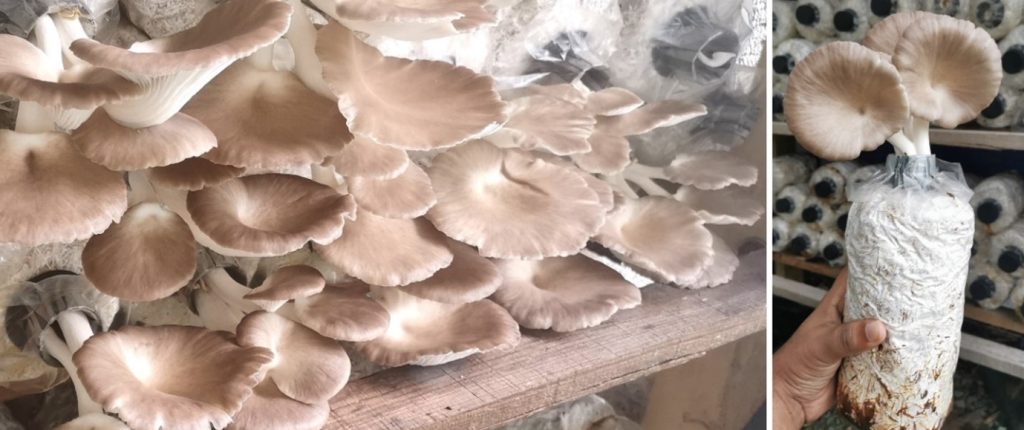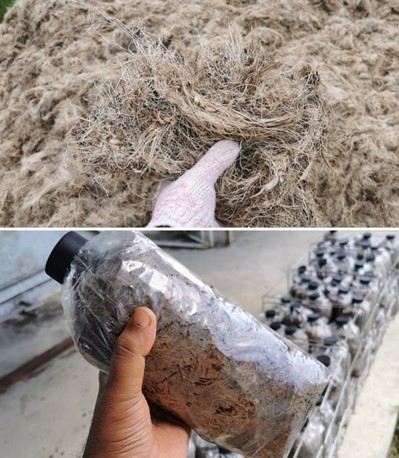Oyster Mushroom Cultivation using Oil Palm Empty Fruit Bunches Fibre

This post is also available in:
This post is also available in:
![]() Español (Spanish)
Español (Spanish) ![]() Ελληνικά (Greek)
Ελληνικά (Greek)
How to make wealth from waste
At least 350 species of fungi are edible, and the global market for edible mushrooms is estimated to be worth USD 42 billion per year (Prescott et al., 2018). It is believed that mushrooms have a high nutritional value and medicinal properties. Numerous investigations have demonstrated oyster mushrooms’ antitumor, anti-inflammatory, antioxidant, and antimicrobial properties (Iwalokun et al., 2007; Patel et al., 2012; Vetvicka et al., 2019;). Due to their simplicity of cultivation and low cost of production, oyster mushrooms (Pleurotus species) are one of the most popular and extensively cultivated edible mushrooms in the world, notably in Asia, North America, and Europe (Hoa et al., 2015; Royse et al., 2017). Moreover, Pleurotus species can be grown on various organic substrates and temperatures (Sánchez, 2010).
On the other hand, agricultural activities generate a large quantity of lignocellulosic-rich organic byproducts and waste that are generally underutilized. These organic wastes could be used as a substrate for mushroom cultivation. Agricultural wastes such as barley straw, wheat straw, rice straw, wheat bran, oil palm empty fruit bunches (OPEFB), corn husk and straw, sugarcane bagasse, etc., have been used to cultivate mushrooms (Hoa et al., 2015; Tesfaw et al., 2015; Pilafids et al., 2022; Rakib et al., 2020; Aubrey et al., 2022).
The potential of oyster mushroom cultivation using OPEFB (Oil Palm Empty Fruit Bunches) fiber
Oil palm is widely cultivated in the Southeast Asian region, especially in Indonesia, Malaysia, and Thailand, where 87% of the global palm oil supplies originate from those countries (USDA, 2023). It was estimated that each tonne of oil palm fresh fruit bunch generated 21% of OPEFB (Alijuboori, 2013), which is produced in abundant volume and easily available. These solid byproducts of oil palm have been used to produce electricity (Hamzah et al., 2019), biogas (Suksong et al., 2016), renewable hydrogen (Hosseini et al., 2015), and compounds for ruminant feeds (Nur-Nazratul et al., 2021). However, only a small fraction of byproducts are utilized and converted into products with added value. Consequently, there is the potential to utilize this byproduct for more sustainable mushroom production.
Benefits/Advantages of mushroom cultivation using OPEFB fiber (oil palm byproducts)
According to Aubrey et al. (2022), there are several advantages in the oyster mushrooms cultivated on OPEFB fiber as compared to the conventional use of rubber wood sawdust (RWS).
Among the advantages are the following:
- Faster production cycle of the mushrooms.
- Better nutritional properties, i.e., relatively higher crude protein and beta-glucan content.
- It is an initiative to promote waste-to-wealth and circular economy concepts and improve food security.
- It could improve the income and livelihoods of urban or rural communities.
- It can improve the usability of low-economic value, cheap, abundant, and easily available local agricultural waste.
- It can support the United Nations Sustainable Development Goals (SDGs), i.e., SDG 1: No poverty; SDG 2: Zero hunger; SDG 9: Industry, innovation, and infrastructure; and SDG 12: Responsible consumption and production.
General steps for mushroom cultivation using OPEFB fiber
These are the general steps in mushroom production using OPEFB fiber in a bag system:
- Processing of OPEFB. This includes mechanical shredding, soaking in water, and rinsing to remove excessive water.
- Packaging of the substrate in heat-resistant polypropylene (PP) or high-density polyethylene (HDPE) bags.
- Pasteurization at 80–100 °C for 5-8 hours.
- Inoculation of mushroom “seeds” or spawn.
- Incubation.
- Mushroom bag opening.
- Pinning or initiation of primordia.
- Development of fruiting bodies.
- Harvesting.
- Repeat steps 5 to 9 for several cycles.
It is highly recommended to compost the mushroom spent or the substrate after completing the cultivation or use it for other purposes instead of disposing of it.
References
Alijuboori, A.H.R. (2013) Oil palm biomass residues in Malaysia: availability and sustainability. International Journal of Biomass and Renewables 2, 13-18.
Aubrey, M.L.L., Chin, C.F.S., Seelan, J.S.S., Chye, F.Y., Lee, H.H., and Rakib, M.R.M. (2022) Conversion of oil palm by-products into value-added products through oyster mushroom (Pleurotus ostreatus) cultivation. Horticulturae 8, 1040.
Hamzah, N., Tokimatsu, K., and Yoshikawa, K. (2019) Solid fuel from oil palm biomass residues and municipal solid waste by hydrothermal treatment for electrical power generation in Malaysia: A review. Sustainability 11, 1060.
Hoa, H.T., Wang, C.L., and Wang, C.H. (2015) The effects of different substrates on the growth, yield, and nutritional composition of two oyster mushrooms (Plerotus ostreatus and Pleurotus cystidiosus). Mycobiology 43, 423-434.
Hosseini, S. E., Wahid, M. A., and Ganjehkaviri, A. (2015) An overview of renewable hydrogen production from thermochemical process of oil palm waste in Malaysia. Energy Conversion and Management 94, 415–429.
Iwalokun, B.A., Usen, U.A., Otunba, A.A., and Olukoya, D.K. (2007) Comparative phytochemical evaluation, antimicrobial and antioxidant properties of Pleurotus ostreatus. African Journal of Biotechnology 6, 1732–1739.
Nur-Nazratul, F.M.Y., Rakib, M.R.M., Zailan, M.Z., and Yaakub, H. (2021) Enhancing in vitro ruminal digestibility of oil palm empty fruit bunch by biological pre-treatment with Ganoderma lucidum fungal culture. PLoS ONE 16: e0258065.
Patel, Y., Naraian, R., and Singh, V.K. (2012) Medicinal properties of Pleurotus species (Oyster mushroom): A Review. World Journal of Fungal and Plant Biology 3, 1–12.
Pilafidis, S., Diamantopoulou, P., Gkatzionis, K., and Sarris, D. (2022) Valorization of agro-Industrial wastes and residues through the production of bioactive compounds by macrofungi in liquid state cultures: Growing circular economy. Applied Sciences 12, 11426.
Prescott, T., Wong, J., Panaretou, B., Boa, E., Bond, A. Chowdhury, S., Davies, L., and Østergaarde, L. (2018) Useful fungi. In: State of the World’s Fungi 2018, K. J. Willis (ed.), Royal Botanical Garden, Kew, pp. 24-31.
Rakib, M.R.M., Lee, A.M.L., and Tan, S.Y. (2020) Corn husk as lignocellulosic agricultural waste for the cultivation of Pleurotus florida mushroom. BioResources 15, 7980–7991.
Royse, D.J., Baars, J.J.P., and Tan, Q. (2017) Current overview of mushroom production in the world. In: Edible and Medicinal Mushroom: Technology and Applications, D.C. Zied, and A. Pardo-Giménez (eds.), Wiley-Blackwell, West Sussex, pp. 5-13.
Sánchez, C. (2010) Cultivation of Pleurotus ostreatus and other edible mushrooms. Applied Microbiology and Biotechnology 85, 1321-1337.
Tesfaw, A., Tadesse, A., and Kiros, G. (2015) Optimization of oyster (Pleurotus ostreatus) mushroom cultivation using locally available substrates and materials in Debre Berhan, Ethiopia. Journal of Applied Biology and Biotechnology 3, 15-20.
Suksong, W., Kongjan, P., Prasertsan, P., Imai, T., and O-Thong, S. (2016) Optimization and microbial community analysis for production of biogas from solid waste resides of palm oil mill industry by solid-state anaerobic digestion. Bioresource Technology 214, 166–174.
United States Department of Agriculture (USDA). (2023) Oilseeds: World Markets and Trade. Foreign Agricultural Service, UDSA, Washington, United States.
Vetvicka, V., Gover, O., Karpovsky, M., Hayby, H., Danay, O., Ezov, N., Hadar, Y., and Schwartz, B. (2019) Immune-modulating activities of glucans extracted from Pleurotus ostreatus and Pleurotus eryngii. Journal of Functional Foods 54, 81–91.










































































